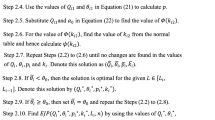Abstract
This article presents a single-vendor and a single-buyer joint economic lot size (JELS) production-distribution inventory model with the prime aim on; the effect of the investment on ordering cost reduction, back order price discount and reduction on lead time. The produced items are delivered to the buyer by adopting a geometric shipment policy. Two continuous review models are developed by assuming that the lead time demand follows a normal distribution and distribution-free. Two types of investments are incorporated to reduce the ordering cost. They are (i) logarithmic investment function and (ii) power investment function. The minimax distribution free approach is adopted in the distribution-free model to find the optimal values of the decision variables by minimizing the expected annual total cost of the system. Numerical examples are given to validate the proposed models. Sensitivity analysis is also performed to analyze the behavior of the key parameters on lot size, ordering cost, backorder price discount, the number of shipments from the vendor to the buyer in one production run and the expected annual total cost of the proposed models.
Similar content being viewed by others
References
Annadurai, K., Uthayakumar, R.: Ordering cost reduction in probabilistic inventory model with controllable lead time and a service level. Int. J. Manag. Sci. Eng. Manag. 5(6), 403–410 (2010)
Banerjee, A.: A joint economic-lot-size model for purchaser and vendor. Decis. Sci. 17(3), 292–311 (1986)
Ben-Daya, M.A., Raouf, A.: Inventory models involving lead time as a decision variable. J. Oper. Res. Soc. 45(5), 579–582 (1994)
Ben-Daya, M., Hariga, M.: Integrated single vendor single buyer model with stochastic demand and variable lead time. Int. J. Prod. Econ. 92(1), 75–80 (2004)
Chuang, B.R., Ouyang, L.Y., Lin, Y.J.: A minimax distribution free procedure for mixed inventory model with backorder discounts and variable lead time. J. Stat. Manag. Syst. 7(1), 65–76 (2004)
Chang, H.C., Ouyang, L.Y., Wu, K.S., Ho, C.H.: Integrated vendor-buyer cooperative inventory models with controllable lead time and ordering cost reduction. Eur. J. Oper. Res. 170(2), 481–495 (2006)
Coates, E.R., Sarker, B.R., Ray, T.G.: Manufacturing setup cost reduction. Comput. Ind. Eng. 31(1–2), 111–114 (1996)
Darwish, M.A.: Economic selection of process mean for single-vendor single-buyer supply chain. Eur. J. Oper. Res. 199(1), 162–169 (2009)
Dey, O., Giri, B.C.: Optimal vendor investment for reducing defect rate in a vendor-buyer integrated system with imperfect production process. Int. J. Prod. Econ. 155, 222–228 (2014)
Gallego, G., Moon, I.: The distribution free newsboy problem: review and extensions. J. Oper. Res. Soc. 44(8), 825–834 (1993)
Giri, B.C., Sharma, S.: Lot sizing and unequal-sized shipment policy for an integrated production-inventory system. Int. J. Syst. Sci. 45(5), 888–901 (2014)
Giri, B.C., Chakraborty, A., Maiti, T.: Consignment stock policy with unequal shipments and process unreliability for a two-level supply chain. Int. J. Prod. Res. 55(9), 2489–2505 (2017)
Glock, C.H.: A comment: “Integrated single vendor-single buyer model with stochastic demand and variable lead time’’. Int. J. Prod. Econ. 122(2), 790–792 (2009)
Glock, C.H.: Lead time reduction strategies in a single-vendor-single-buyer integrated inventory model with lot size-dependent lead times and stochastic demand. Int. J. Prod. Econ. 136(1), 37–44 (2012)
Glock, C.H.: The joint economic lot size problem: a review. Int. J. Prod. Econ. 135(2), 671–686 (2012)
Glock, C.H., Grosse, E.H., Ries, J.M.: The lot sizing problem: a tertiary study. Int. J. Prod. Econ. 155, 39–51 (2014)
Goyal, S.K.: An integrated inventory model for a single supplier-single customer problem. Int. J. Prod. Res. 15(1), 107–111 (1977)
Goyal, S.K.: “A joint economic-lot-size model for purchaser and vendor’’: a comment. Decis. Sci. 19(1), 236–241 (1988)
Goyal, S.K.: A one-vendor multi-buyer integrated inventory model: a comment. Eur. J. Oper. Res. 82(1), 209–210 (1995)
Goyal, S.K., Nebebe, F.: Determination of economic production-shipment policy for a single-vendor-single-buyer system. Eur. J. Oper. Res. 121(1), 175–178 (2000)
Hill, R.M.: The single-vendor single-buyer integrated production-inventory model with a generalised policy. Eur. J. Oper. Res. 97(3), 493–499 (1997)
Hill, R.M.: The optimal production and shipment policy for the single-vendor single-buyer integrated production-inventory problem. Int. J. Prod. Res. 37(11), 2463–2475 (1999)
Ho, C.H.: A minimax distribution free procedure for an integrated inventory model with defective goods and stochastic lead time demand. Int. J. Inf. Manag. Sci. 20(1), 161–171 (2009)
Hoque, M.A., Goyal, S.K.: A heuristic solution procedure for an integrated inventory system under controllable lead-time with equal or unequal sized batch shipments between a vendor and a buyer. Int. J. Prod. Econ. 102(2), 217–225 (2006)
Hoque, M.A.: A manufacturer-buyer integrated inventory model with stochastic lead times for delivering equal-and/or unequal-sized batches of a lot. Comput. Oper. Res. 40(11), 2740–2751 (2013)
Hsu, S.L., Lee, C.C.: Replenishment and lead time decisions in manufacturer-retailer chains. Transp. Res. Part E Logist. Transp. Rev. 45(3), 398–408 (2009)
Kim, S.L., Hayya, J.C., Hong, J.D.: Setup reduction in the economic production quantity model. Decis. Sci. 23(2), 500–508 (1992)
Kotler, P., Keller, K.L.: Marketing management, 12th edn. Prentice-Hall, Upper Saddle River (2006)
Lin, Y.J.: An integrated vendor-buyer inventory model with backorder price discount and effective investment to reduce ordering cost. Comput. Ind. Eng. 56(4), 1597–1606 (2009)
Hsien-Jen, L.I.N.: An integrated supply chain inventory model with imperfect-quality items, controllable lead time and distribution-free demand. Yugosl. J. Oper. Res. 23(1), 87–109 (2013)
Lu, L.: A one-vendor multi-buyer integrated inventory model. Eur. J. Oper. Res. 81(2), 312–323 (1995)
Liao, C.J., Shyu, C.H.: An analytical determination of lead time with normal demand. Int. J. Oper. Prod. Manag. 11(9), 72–78 (1991)
Ouyang, L.Y., Chen, C.K., Chang, H.C.: Lead time and ordering cost reductions in continuous review inventory systems with partial backorders. J. Oper. Res. Soc. 50(12), 1272–1279 (1999)
Ouyang, L.Y., Wu, K.S., Ho, C.H.: Integrated vendor-buyer cooperative models with stochastic demand in controllable lead time. Int. J. Prod. Econ. 92(3), 255–266 (2004)
Ouyang, L.Y., Wu, K.S., Ho, C.H.: An integrated vendor-buyer inventory model with quality improvement and lead time reduction. Int. J. Prod. Econ. 108(1), 349–358 (2007)
Ouyang, L.Y., Chuang, B.R., Lin, Y.J.: The inter-dependent reductions of lead time and ordering cost in periodic review inventory model with backorder price discount. Int. J. Inf. Manag. Sci. 18(3), 195 (2007)
Porteus, E.L.: Investing in reduced setups in the EOQ model. Manag. Sci. 31(8), 998–1010 (1985)
Pan, J.C.H., Hsiao, Y.C.: Inventory models with back-order discounts and variable lead time. Int. J. Syst. Sci. 32(7), 925–929 (2001)
Pan, J.C.H., Yang, J.S.: A study of an integrated inventory with controllable lead time. Int. J. Prod. Res. 40(5), 1263–1273 (2002)
Pan, J.C.H., Lo, M.C., Hsiao, Y.C.: Optimal reorder point inventory models with variable lead time and backorder discount considerations. Eur. J. Oper. Res. 158(2), 488–505 (2004)
Pan, J.C.H., Hsiao, Y.C.: Integrated inventory models with controllable lead time and backorder discount considerations. Int. J. Prod. Econ. 93, 387–397 (2005)
Pandey, A., Masin, M., Prabhu, V.: Adaptive logistic controller for integrated design of distributed supply chains. J. Manuf. Syst. 26(2), 108–115 (2007)
Sajadieh, M.S., Jokar, M.R.A., Modarres, M.: Developing a coordinated vendor-buyer model in two-stage supply chains with stochastic lead-times. Comput. Oper. Res. 36(8), 2484–2489 (2009)
Teng, J.T., Cárdenas-Barrón, L.E., Lou, K.R.: The economic lot size of the integrated vendor-buyer inventory system derived without derivatives: a simple derivation. Appl. Math. Comput. 217(12), 5972–5977 (2011)
Tsou, C.S., Fang, H.H., Lo, H.C., Huang, C.H.: A study of cooperative advertising in a manufacturer-retailer supply chain. Int. J. Inf. Manag. Sci. 20(12), 5–26 (2009)
Woo, Y.Y., Hsu, S.L., Wu, S.: An integrated inventory model for a single vendor and multiple buyers with ordering cost reduction. Int. J. Prod. Econ. 73(3), 203–215 (2001)
Zhang, T., Liang, L., Yu, Y., Yu, Y.: An integrated vendor-managed inventory model for a two-echelon system with order cost reduction. Int. J. Prod. Econ. 109(1), 241–253 (2007)
Acknowledgements
The work of authors are supported by Department of Science and Technology-Science and Engineering Research Board (DST-SERB), Government of India, New Delhi, under the grant number DST-SERB/SR/S4/MS: 814/13-Dated 24.04.2014.
Author information
Authors and Affiliations
Corresponding author
Additional information
Publisher's Note
Springer Nature remains neutral with regard to jurisdictional claims in published maps and institutional affiliations.
Appendices
Appendix 1
Similar to the results proved in Lin [30] the convexity of the cost function is discussed.
Observation 1
\(EATCI_{N}^{L}(n, q_{1}, k, A_{b}, \pi _{x}, L)\) is concave in \(L \in [L_{i}, L_{i-1}]\) for a fixed \(n, q_{1}, k, A_{b}, \pi _{x}\).
Thus for a fixed \((n, q_{1}, k, A_{b}, \pi _{x})\), \(EATCI_{N}^{L}(n, q_{1}, k, A_{b}, \pi _{x}, L)\) is concave in \(L \in [L_{i}, L_{i-1}]\). Hence the minimum value of \(EATCI_{N}^{L}(n, q_{1}, k, A_{b}, \pi _{x}, L)\) exists at the end points of the interval \([L_{i}, L_{i-1}]\).
Observation 2
\(EATCI_{N}^{L}(n, q_{1}, k, A_{b}, \pi _{x}, L)\) is convex in n for a fixed \(k, q_{1}, L, A_{b}, \pi _{x}\).
where \(Y = \Bigl (A_{b}+\frac{A_{v}}{n}\Bigr ) +G(\pi _x)\sigma \sqrt{L}\psi (k)+R(L)+T_{r}\)
Observation 3
\(EATCI_{N}^{L}(n, q_{1}, k, A_{b}, \pi _{x}, L)\) is convex in \(q_{1}\) for a fixed \(n, k, L, A_{b}, \pi _{x}\).
Observation 4
\(EATCI_{N}^{L}(n, q_{1}, k, A_{b}, \pi _{x}, L)\) is convex in k for a fixed \(n, q_{1}, L, A_{b}, \pi _{x}\).
Observation 5
\(EATCI_{N}^{L}(n, q_{1}, k, A_{b}, \pi _{x}, L)\) is convex in \(\pi _{x}\) for a fixed \(n, q_{1}, L, A_{b}, k\).
Observation 6
\(EATCI_{N}^{L}(n, q_{1}, k, \pi _{x}, \pi _{x}, L)\) is convex in \(A_{b}\) for a fixed \(n, q_{1}, L, \pi _{x}, k\).
Observation 7
\(EATCI_{F}^{L}(n, q_{1}, k, A_{b}, \pi _{x}, L)\) is concave in \(L \in [L_{i}, L_{i-1}]\) for a fixed \(n, q_{1}, k, A_{b}, \pi _{x}\).
Thus for a fixed \((n, q_{1}, k, A_{b}, \pi _{x})\), \(EATCI_{F}^{L}(n, q_{1}, k, A_{b}, \pi _{x}, L)\) is concave in \(L \in [L_{i}, L_{i-1}]\). Hence the minimum value of \(EATCI_{N}^{L}(n, q_{1}, k, A_{b}, \pi _{x}, L)\) exists at the end points of the interval \([L_{i}, L_{i-1}]\).
Observation 8
\(EATCI_{F}^{L}(n, q_{1}, k, A_{b}, \pi _{x}, L)\) is convex in n for a fixed \(k, q_{1}, L, A_{b}, \pi _{x}\),.
where \(Y = \Bigl (A_{b}+\frac{A_{v}}{n}\Bigr ) +G(\pi _x)\sigma \sqrt{L}K+R(L)+T_{r}\)
Observation 9
\(EATCI_{F}^{L}(n, q_{1}, k, A_{b}, \pi _{x}, L)\) is convex in \(q_{1}\) for a fixed \(n, k, L, A_{b}, \pi _{x}\),.
Observation 10
\(EATCI_{F}^{L}(n, q_{1}, k, A_{b}, \pi _{x}, L)\) is convex in k for a fixed \(n, q_{1}, L, A_{b}, \pi _{x}\).
Observation 11
\(EATCI_{F}^{L}(n, q_{1}, k, A_{b}, \pi _{x}, L)\) is convex in \(\pi _{x}\) for a fixed \(n, q_{1}, L, A_{b}, k\).
Observation 12
\(EATCI_{F}^{L}(n, q_{1}, k, \pi _{x}, \pi _{x}, L)\) is convex in \(A_{b}\) for a fixed \(n, q_{1}, L, \pi _{x}, k\).
Appendix 2
As the total cost function of the integrated system is highly non-linear, the convexity of the function for a given L is checked in the distribution free case when logarithmic investment function is adopted. For this case, the Hessian matrix H is given below. The leading principal minors \(H_{55}, H_{44}, H_{33}, H_{22}, H_{11}\) are positive and thus the hessian matrix is positive definite. Thus the solution obtained is globally optimum.
Rights and permissions
About this article
Cite this article
Latha, K.F.M., Kumar, M.G. & Uthayakumar, R. Two echelon economic lot sizing problems with geometric shipment policy backorder price discount and optimal investment to reduce ordering cost. OPSEARCH 58, 1133–1163 (2021). https://doi.org/10.1007/s12597-021-00515-7
Accepted:
Published:
Issue Date:
DOI: https://doi.org/10.1007/s12597-021-00515-7









